
Sardinia is the second-largest island in the Mediterranean Sea, after Sicily, and one of the 20 regions of Italy. It is located west of the Italian Peninsula, north of Tunisia and immediately south of the French island of Corsica.

Bertoleoni is the self-proclaimed ruling family of the self-styled "Kingdom of Tavolara", which claimed to be "the smallest kingdom of the world". The members of this family were also the only inhabitants of this island that had been abandoned in 1962. They sustained themselves by goat farming and fishing. Currently, the supposed kingdom is a tourist attraction for the 50 or so native inhabitants of the island, where the current "king" and "crown princess" run its two restaurants and sell souvenirs to visitors of the Natural Park.
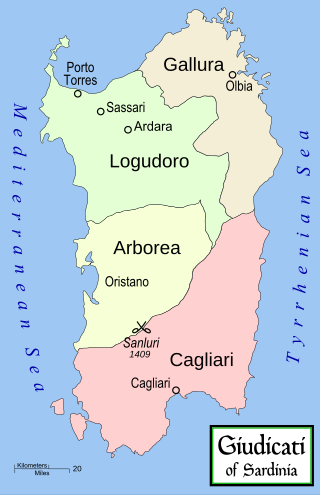
The Judicates, in English also referred to as Sardinian Kingdoms, Sardinian Judgedoms or Judicatures, were independent states that took power in Sardinia in the Middle Ages, between the ninth and fifteenth centuries. They were sovereign states with summa potestas, each with a ruler called judge, with the powers of a king.

The province of Sassari is a province in the autonomous island region of Sardinia in Italy. Its capital is the city of Sassari. As of 2017, the province had a population of 493,357 inhabitants.
Sardinia is probably the most culturally distinct of all the regions in Italy and, musically, is best known for the tenore polyphonic singing, sacred chants called gosos, the launeddas, an ancient instrument that consists of a set of three single-reed pipes, all three mouth-blown simultaneously using circular breathing, with two chanters and one drone and the cantu a chiterra, a monodic song that is accompanied by guitar, widespread mainly in the center and north of the island.
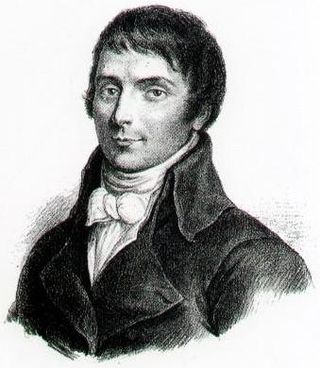
Giovanni Maria Angioy was a Sardinian politician and patriot and is considered to be a national hero by Sardinian nationalists. Although best known for his political activities, Angioy was a university lecturer, a judge for the Reale Udienza, an entrepreneur and a banker.

The Logudoro is a large traditional region Sardinia, Italy. The name of Logudoro today is linked to the Logudorese dialect, which covers a large area of northern-central Sardinia.

The Kingdom of Sardinia, also referred to as the Kingdom ofSardinia-Piedmont or Piedmont-Sardinia during the Savoyard period, was a state in Southern Europe from the early 14th until the mid-19th century.

The Nora Stone or Nora Inscription is an ancient Phoenician inscribed stone found at Nora on the south coast of Sardinia in 1773. Though it was not discovered in its primary context, it has been dated by palaeographic methods to the late 9th century to early 8th century BCE and is still considered the oldest Phoenician inscription found anywhere outside of the Levant.

The Sardinians, or Sards, are a Romance language-speaking ethnic group native to Sardinia, from which the western Mediterranean island and autonomous region of Italy derives its name.

The Perfect Fusion was the 1847 act of the Savoyard king Charles Albert of Sardinia which abolished the administrative differences between the mainland states and the island of Sardinia, in a fashion similar to the Nueva Planta decrees between the Crown of Castile and the realms of the Crown of Aragon between 1707 and 1716 and the Acts of Union between Great Britain and Ireland in 1800.

Sardinian nationalism or also Sardism is a social, cultural and political movement in Sardinia calling for the self-determination of the Sardinian people in a context of national devolution, further autonomy in Italy, or even outright independence from the latter. It also promotes the protection of the island's environment and the preservation of its cultural heritage.

The literature of Sardinia is the literary production of Sardinian authors, as well as the literary production generally referring to Sardinia as argument, written in various languages.
This article presents a history of Cagliari, an Italian municipality and the capital city of the island of Sardinia. The city has been continuously inhabited since at least the neo-lithic period. Due to its strategic location in the Mediterranean and natural harbor, the city was prized and highly sought after by a number of Mediterranean empires and cultures.
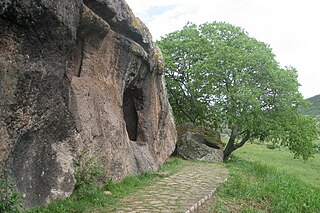
The necropolis of Sant'Andrea Priu is an archaeological site located on the south side of the fertile plain of Saint Lucia, in the municipality of Bonorva, Sardinia. The complex, one of the most important of the island, is composed of twenty domus de janas; one of them with its eighteen rooms appears to be one of the largest hypogean tombs of the Mediterranean basin.
Su patriotu sardu a sos feudatarios, widely known also by its incipit as Procurade 'e moderare, is a protest and antifeudal folk song in the culture of Sardinia.
The gosos or goccius are a kind of devotional and paraliturgical songs of Iberian origin typical of Sardinia, and written in the Sardinian language.

The Treaty of Stupinigi was signed on November 8th and 10th 1817, in Stupinigi between Honoré V, Prince of Monaco, and Victor Emmanuel I of Sardinia.
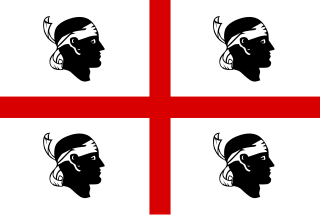
The Kingdom of Sardinia, was a feudal state in Southern Europe created in the early 14 century and a possession of the Crown of Aragon first and then of the Spanish Empire.
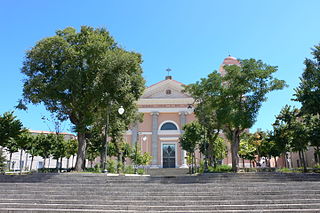
Frà Antonio Cano (1779–1840) was a sculptor, architect, and lay friar of the Kingdom of Sardinia.

















